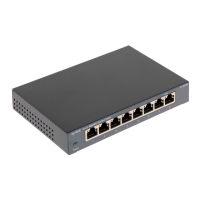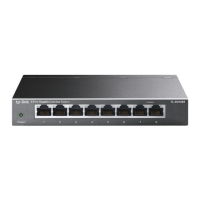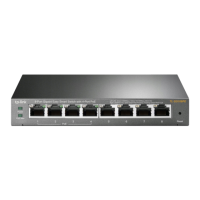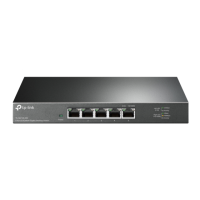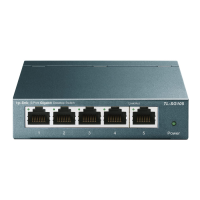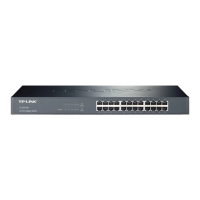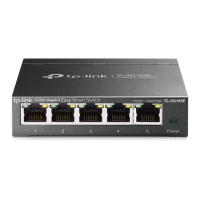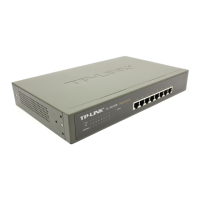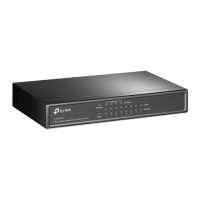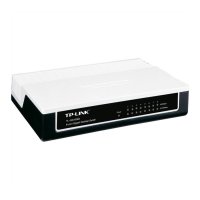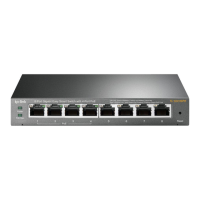Do you have a question about the TP-Link TL-SG108E and is the answer not in the manual?
Target audience for the guide, focusing on network managers.
Explains symbols and formatting used in the guide for clarity.
Provides links for software, documentation, forums, and support.
Overview of the switch's purpose and key features.
Details the physical layout and components of the switch.
Step-by-step guide to accessing the switch via a web browser.
Introduces the System module for configuration and information viewing.
How to view and specify system information like device description.
Steps to configure the switch's IP address using DHCP or manually.
Process for modifying the administrator's username and password for security.
Instructions for saving and restoring switch configurations.
Guides on how to restart and reset the switch to factory defaults.
Procedure for updating the switch firmware for new features and performance.
Lists default settings for system, IP, and user account configurations.
Introduces switching features like port setting, IGMP Snooping, and LAG.
Steps to configure port status, speed, duplex mode, and flow control.
Guide on enabling and configuring IGMP Snooping for efficient multicast traffic.
Instructions for setting up LAGs to increase bandwidth and reliability.
Practical examples for IGMP Snooping and LAG configuration.
Lists default settings for Port, IGMP Snooping, and LAG.
Introduces the monitoring feature for observing network traffic.
Details how to view traffic statistics for each port on the switch.
Guide on setting up port mirroring to monitor network traffic.
Instructions for using the cable test feature to diagnose connection issues.
Steps to enable and configure loop prevention to avoid network disruptions.
Lists default settings for Port Mirror and Loop Prevention.
Explains VLANs and their benefits for network management and segmentation.
Steps to configure the MTU VLAN mode and set the uplink port.
Guide on configuring VLANs based on individual ports.
Detailed steps for configuring 802.1Q VLANs, including VLAN creation and PVID.
Practical example illustrating 802.1Q VLAN setup for network segmentation.
Lists default settings for MTU VLAN, Port Based VLAN, and 802.1Q VLAN.
Explains QoS for traffic prioritization and performance.
Details QoS modes (Port Based, 802.1P, DSCP) and configuration guidelines.
Steps to configure QoS prioritizing traffic based on ingress ports.
Steps to configure QoS prioritizing traffic based on 802.1P tag values.
Steps to configure QoS prioritizing traffic based on DSCP values.
Guide on setting ingress and egress bandwidth limits for ports.
Steps to configure storm control to limit broadcast, multicast, and unicast traffic.
Practical example demonstrating how to prioritize specific traffic using port-based QoS.
Lists default settings for QoS Basic, Bandwidth Control, and Storm Control.
FCC compliance statements and warnings for Class B digital devices.
FCC compliance statements and warnings for Class A digital devices.
CE mark warnings for Class B products in domestic environments.
CE mark warnings for Class A products in domestic environments.
Statement of compliance with essential EU directives.
Industry Canada compliance statements for specific models.
Safety advice and precautions for using the product.
Guidelines for safe operation, avoiding water, fire, and modification.
Explanation of symbols on the product label, such as AC voltage.
Information on product recycling and compliance with the WEEE directive.
Target audience for the guide, focusing on network managers.
Explains symbols and formatting used in the guide for clarity.
Provides links for software, documentation, forums, and support.
Overview of the switch's purpose and key features.
Details the physical layout and components of the switch.
Step-by-step guide to accessing the switch via a web browser.
Introduces the System module for configuration and information viewing.
How to view and specify system information like device description.
Steps to configure the switch's IP address using DHCP or manually.
Process for modifying the administrator's username and password for security.
Instructions for saving and restoring switch configurations.
Guides on how to restart and reset the switch to factory defaults.
Procedure for updating the switch firmware for new features and performance.
Lists default settings for system, IP, and user account configurations.
Introduces switching features like port setting, IGMP Snooping, and LAG.
Steps to configure port status, speed, duplex mode, and flow control.
Guide on enabling and configuring IGMP Snooping for efficient multicast traffic.
Instructions for setting up LAGs to increase bandwidth and reliability.
Practical examples for IGMP Snooping and LAG configuration.
Lists default settings for Port, IGMP Snooping, and LAG.
Introduces the monitoring feature for observing network traffic.
Details how to view traffic statistics for each port on the switch.
Guide on setting up port mirroring to monitor network traffic.
Instructions for using the cable test feature to diagnose connection issues.
Steps to enable and configure loop prevention to avoid network disruptions.
Lists default settings for Port Mirror and Loop Prevention.
Explains VLANs and their benefits for network management and segmentation.
Steps to configure the MTU VLAN mode and set the uplink port.
Guide on configuring VLANs based on individual ports.
Detailed steps for configuring 802.1Q VLANs, including VLAN creation and PVID.
Practical example illustrating 802.1Q VLAN setup for network segmentation.
Lists default settings for MTU VLAN, Port Based VLAN, and 802.1Q VLAN.
Explains QoS for traffic prioritization and performance.
Details QoS modes (Port Based, 802.1P, DSCP) and configuration guidelines.
Steps to configure QoS prioritizing traffic based on ingress ports.
Steps to configure QoS prioritizing traffic based on 802.1P tag values.
Steps to configure QoS prioritizing traffic based on DSCP values.
Guide on setting ingress and egress bandwidth limits for ports.
Steps to configure storm control to limit broadcast, multicast, and unicast traffic.
Practical example demonstrating how to prioritize specific traffic using port-based QoS.
Lists default settings for QoS Basic, Bandwidth Control, and Storm Control.
FCC compliance statements and warnings for Class B digital devices.
FCC compliance statements and warnings for Class A digital devices.
CE mark warnings for Class B products in domestic environments.
CE mark warnings for Class A products in domestic environments.
Statement of compliance with essential EU directives.
Industry Canada compliance statements for specific models.
Safety advice and precautions for using the product.
Guidelines for safe operation, avoiding water, fire, and modification.
Explanation of symbols on the product label, such as AC voltage.
Information on product recycling and compliance with the WEEE directive.
| Switch type | Managed |
|---|---|
| Switch layer | L2 |
| Quality of Service (QoS) support | Yes |
| Installed SFP modules quantity | - |
| Basic switching RJ-45 Ethernet ports type | Gigabit Ethernet (10/100/1000) |
| Basic switching RJ-45 Ethernet ports quantity | 8 |
| 10G support | No |
| Number of VLANs | 32 |
| Networking standards | IEEE 802.1ab, IEEE 802.1p, IEEE 802.1Q, IEEE 802.3, IEEE 802.3u, IEEE 802.3x |
| Virtual LAN features | Port-based VLAN |
| Cable types supported | Cat3, Cat4, Cat5, Cat5e |
| Security algorithms | SNMP, SNMPv2, SNMPv3 |
| Jumbo frames | 15000 |
| Forwarding rate | 11.9 Mpps |
| MAC address table | 4000 entries |
| Packet buffer memory | 1.5 MB |
| Certification | FCC, CE, RoHS |
| Product color | Black |
| Housing material | Metal |
| Heat dissipation | 12.12 BTU/h |
| Storage temperature (T-T) | -40 - 70 °C |
| Operating temperature (T-T) | 0 - 40 °C |
| Storage relative humidity (H-H) | 5 - 90 % |
| Operating relative humidity (H-H) | 10 - 90 % |
| Power source | DC |
| Input current | 0.6 A |
| Input voltage | 9 V |
| Power consumption (max) | 3.55 W |
| Package type | Box |
| Package depth | 191 mm |
| Package width | 130 mm |
| Package height | 92 mm |
| Package weight | 630 g |
| Cables included | AC |
| Depth | 101 mm |
|---|---|
| Width | 158 mm |
| Height | 25 mm |
